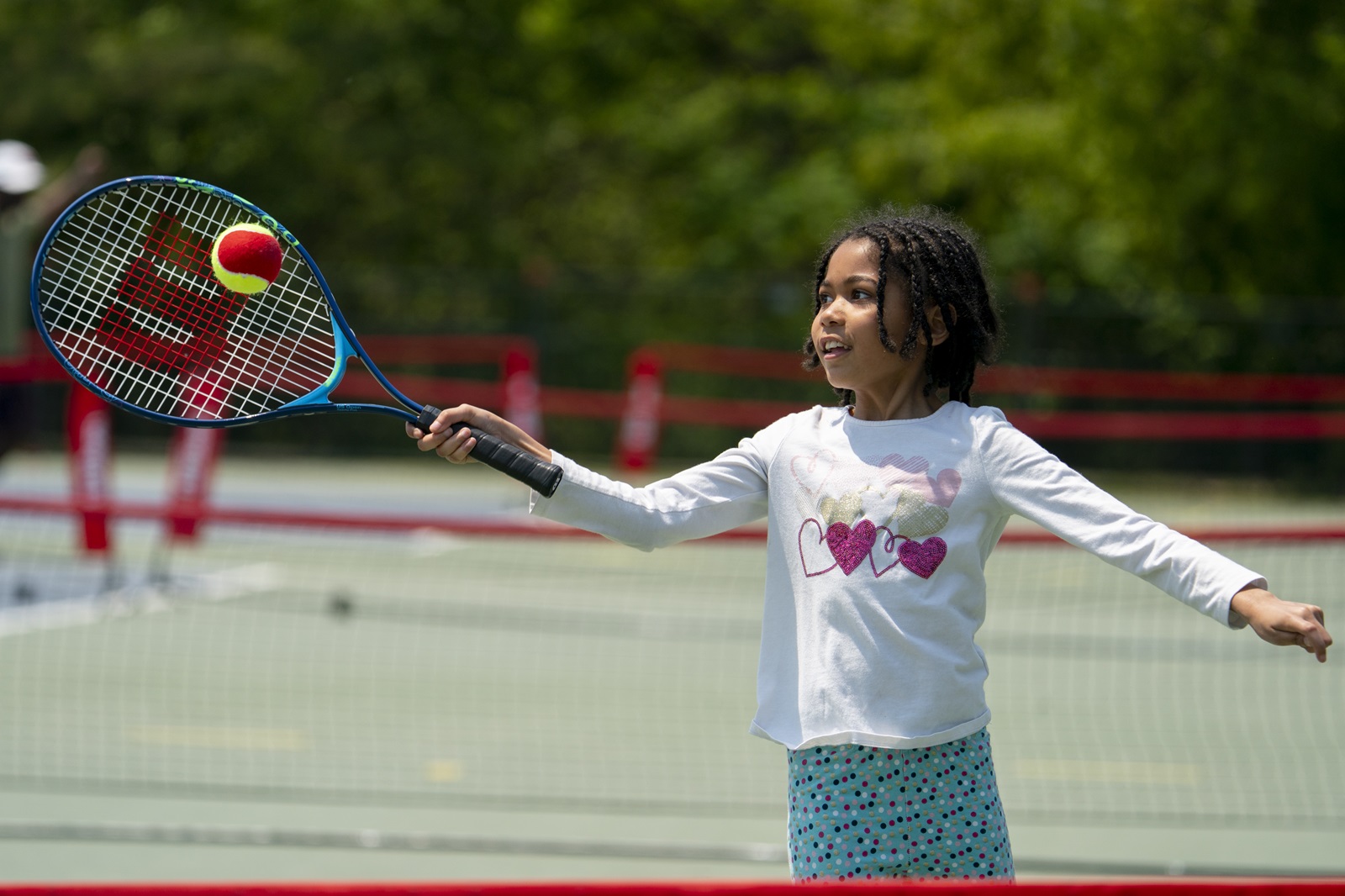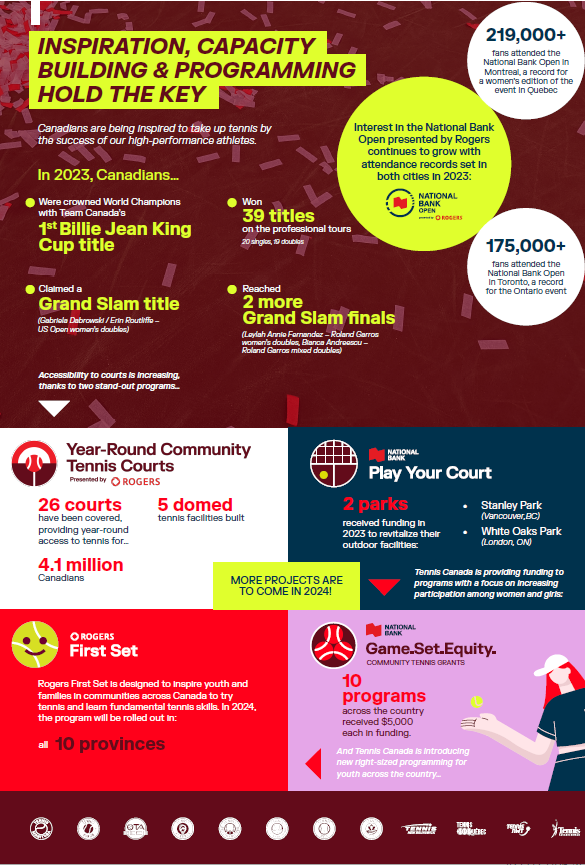“It means so much for Canadian tennis”: How Marina Stakusic’s post-BJK Cup claim predicted a rise for tennis in Canada
January 31, 2024
A Canadian flag draped around her shoulders, a beaming, then-18-year-old Marina Stakusic is flanked by captain Heidi El Tabakh and Gabriela Dabrowski on the hard courts of Estadio de la Cartuja. Just minutes earlier, Leylah Annie Fernandez flung her racquet into the air and was embraced by her jubilant teammates having hit a flawless cross-court backhand beyond the reach of an outstretched Jasmine Paolini of Italy on match point.
“It obviously means so much for Canadian tennis,” Stakusic says, as a bank of vocal, red and white clad fans serenade the new world champions while the team hits pause on its adrenaline-fueled celebrations long enough to compose themselves and complete their post-match media commitments.
That was the scene in Seville, Spain last November as Team Canada presented by Sobeys clinched the country’s first-ever Billie Jean King Cup title. For a week or two, the silverware sat proudly on the Canadian tennis mantlepiece alongside the Davis Cup trophy that Frank Dancevic, Félix Auger-Aliassime, Denis Shapovalov, Vasek Pospisil and co. had brought home just shy of 12 months prior.
If it hadn’t already, as world champions of women’s and men’s tennis, Canada confirmed its seat at the top table of elite tennis nations. But the ripple effect of hoisting the Billie Jean King and Davis Cup goes far beyond the act itself. In parallel with its fortunes on the international stage, tennis in Canada has experienced a movement on its own shores.
Recently, Tennis Canada announced the results of an interest and participation study, conducted by YouGov Canada, which showed tennis on the rise and that youth are leading the charge. In fact, nearly 5 million Canadians picked up a racquet in the past year. That marks the first time the sport has seen such a significant rise in both categories since COVID-19, signaling a potential return to pre-pandemic levels in the near future.

“The growth we have seen in interest and participation in 2023 is highly encouraging, especially among the younger demographic,” newly appointed Tennis Canada CEO Gavin Ziv affirmed. “Tennis Canada’s strategy for many years has been to invest in high performance to ensure we have more players competing on the biggest stage and inspirating the nation to pick up a racquet. As we can see, this strategy is paying off and helping Tennis Canada and our Provincial and Territorial Association partners to grow the sport across the country.”
Beyond the Billie Jean King Cup triumph, Canadian tennis enjoyed some monumental moments in 2023. Dabrowski and her partner Erin Routliffe captured the nation’s first Grand Slam women’s doubles title at the US Open in September. Meanwhile, the National Bank Open presented by Rogers (NBO) broke attendance records in 2023 as fans flocked to Canada’s premier, world-class tennis tournaments to watch the globe’s best players compete in-person at Sobeys Stadium and IGA Stadium respectively.
All these major milestones serve to motivate wave after wave of potential new participants. The same was true in 2019, when Bianca Andreescu broke onto the global scene with iconic victories at the NBO, becoming the first Canadian champion on home soil in 50 years (Faye Urban, 1969), and US Open as she sealed Canada’s maiden Grand Slam title, beating tennis legend Serena Williams on both occasions.
At her homecoming press conference in the days following that triumph at New York’s Arthur Ashe Stadium, Andreescu was unequivocal in her ambition to influence others to play tennis. “One of my goals was to be an inspiration to many people and I think I’m starting to do that, which means a lot,” she said to a packed room of reporters and photographers. “If I step on the court and I show a good example, I think it can drive a lot of people to maybe even pick up a racquet.”

So, who inspired Bianca, Marina, Félix and Denis? Well, there’s no looking past 2014 and 2016 Wimbledon finalists Eugenie Bouchard and Milos Raonic, who were also the first Canadians to break into the world’s top 5 on the WTA and ATP Tour respectively. “Tennis and the appreciation for tennis in Canada has considerably grown,” Raonic said close to eight years ago, following his finals defeat to Andy Murray on the All England Lawn Tennis Club’s hallowed Centre Court.
Before Eugenie and Milos, there was 12-time Grand Slam doubles champion Daniel Nestor, and before him, Helen Kelesi, then Robert Bedard.
But, who’s coming next? The answer to that question is more exciting with every Canadian that picks up a racquet.
Click here to read more about Canada’s increasing tennis interest and participation rates.
About the Author(s)
Founded in 1890, Tennis Canada is a non-profit, national sport association with a mission to lead the growth, development and promotion of tennis in Canada and a vision to be a world-leading tennis nation. Tennis Canada is a proud member of the International Tennis Federation, the Canadian Olympic Committee and the Canadian Paralympic Committee, and serves to administer, sponsor and select the teams for Davis Cup, Billie Jean King Cup, the Olympic and Paralympic Games and all wheelchair, junior and senior national teams.
The information presented in SIRC blogs and SIRCuit articles is accurate and reliable as of the date of publication. Developments that occur after the date of publication may impact the current accuracy of the information presented in a previously published blog or article.
